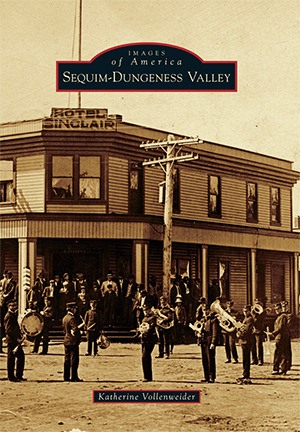“Sequim-Dungeness Valley
(Images of America)” book signing
Who: Author Katherine Vollenweider
Where: Sequim Museum & Arts, 175 West Cedar St., Sequim
When: 5-7 p.m. Friday, Dec. 18
Book cost: $21.99 with, profits benefiting the museum
From boat pictures to trains to local landmarks like the lighthouse, there’s a little bit of everything for fans of the Sequim-Dungeness Valley to peruse in author Katherine Vollenweider’s new book.
Last week, she released “Sequim-Dungeness Valley (Images of America)” from Arcadia Publishing revealing never-before-seen photos and documents showing significant pieces of the area’s history from the 1800s, roughly the 1850s, to the 1930s. She hosts a book signing at the Sequim Museum & Arts Center from 5-7 p.m. Friday, Dec. 18.
Since her time as director of the Sequim Museum & Arts, she’s considered compiling a cohesive photographic timeline of the area and figured using materials she wrote in Sequim would be enough. But she wasn’t 100 percent certain some of the source material was accurate.
“When I started to put things down I wasn’t sure the sources I was using were fact-checked,” Vollenweider said. “I started to do a little poking around and realized I had to start all over.”
A planned three-month project ballooned into more than a year and hundreds of hours searching microfiche, online digital newspapers and other archives through the Jamestown S’Klallam Tribe, University of Washington, Puget Sound Maritime Historical Society and the Sequim Museum & Arts.
Her goal was to use primary source documents from the time period, such as a telegraph from the 1850s that reveals some details about the New Dungeness settlement at the time.
While “Sequim-Dungeness Valley” is a heavily visual book, Vollenweider said she tried to include as much information as possible about topics centered around the Jamestown S’Klallam Tribe, the creation of Dungeness and New Dungeness – Old Town and how the area became agriculture-focused.
Vollenweider stopped her book’s timeline around 1930, she said, because of the wealth of information available already on the area after that period. She also wanted to avoid duplicating photos that people have seen or used before.
While she was limited somewhat by going as far back as the photos did, some of the photos were hard to timestamp. However, she received a lot of help identifying people and places from museum executive director Judy Stipe and tribal employees who asked family and locals for help.
To put the historical Sequim-Dungeness Valley in perspective, Vollenweider includes in some of the photo captions where it correlates with today’s geography.
But one geographic phrase that befuddles her is calling the area a valley.
“The term ‘Sequim–Dungeness Valley’ puzzles me, as there is no northern counterpart to the Olympic Mountains that rise to the south and no peaks en route west to Port Angeles,” she wrote in her introduction.
“The Dungeness River empties a watershed of over 170,000 acres and drops at a 3.3 percent grade, but the upper river reaches are not the ‘valley’ as used colloquially.”
She suggests calling the area a prairie might be more accurate “albeit offering a much different image than that of a pastoral valley with gentle, grazing cows.”
Vollenweider tried to discover the valley’s origins but believes it may have been worded in the 1960s.
Valleys and prairies aside, and despite her vast knowledge and love of the Sequim-Dungeness Valley, Vollenweider no longer lives in Sequim as she works in the maritime industry as an environmental technician working on oil spill response. At one point, she had difficulty trying to send a proof of her book from 1,500 miles offshore of Mexico on different expedition.
She worked as the Sequim Museum’s registrar from 2003-2006 and its director from 2006-2010 and continues to donate her time doing research here.
For more information on her book’s availability, call the museum at 683-8110.



